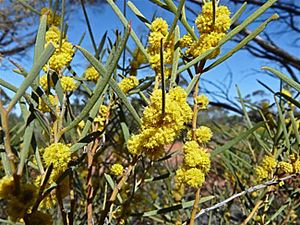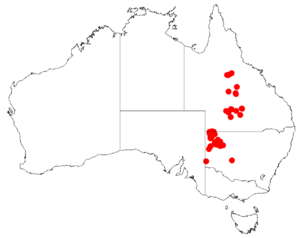Cabbage-tree wattle facts for kids
Quick facts for kids Cabbage-tree wattle |
|
|---|---|
 |
|
| Scientific classification | |
| Genus: |
Acacia
|
| Species: |
cana
|
 |
|
| Occurrence data from AVH | |
The Acacia cana, also known as boree, cabbage-tree wattle, or broad-leaved nealie, is a special plant from Australia. It belongs to the pea family, called Fabaceae, and a smaller group within it, the Mimosoideae.
This plant is a thick shrub or small tree. It can grow up to 6 metres (20 ft) tall. It's a perennial plant, which means it lives for many years. The cabbage-tree wattle has lots of bright yellow flowers from August to October. Animals and insects help it spread its pollen and seeds. This type of acacia is not in danger of disappearing. You can find it in the western plains of New South Wales and Central Queensland. It likes sandy soils and rocky areas called gibber plains.
Contents
What is the Cabbage-Tree Wattle Like?
The Acacia cana is one of Australia's native wattle trees. It can grow to about 6 meters (20 feet) tall. It's a dense shrub or small tree. People sometimes say it looks twisted or unusual in shape.
This native plant lives for many years. It produces 15 to 35 bright yellow or golden flowers. These flowers appear from August to October. The plant has special branches called phyllodes. They are 5–13 cm long and covered in fine silver hairs. Its leaves are thin, about 6 cm long and 5 mm wide. The seed pods are slightly curved and thin, about 10 cm long, and also covered in fine hairs. A special feature of Acacia cana is a gland at its base. Most of the plant is covered in tiny hairs, and its bark is grey.
Where Does the Cabbage-Tree Wattle Grow?
The Acacia cana is found in the western plains of New South Wales. You can see it near places like White Cliffs, The Sturt National Park, and Merindee. It also grows further north in Central Queensland, near Avadale.
These areas are often woodlands with scattered trees. The soil is usually sandy, or it can be rocky gibber plains. The cabbage-tree wattle grows well here. It often grows alongside other acacia types, leopardwood (Flindersia maculosa), and belah (Casuarina cristata) trees.
How Does the Cabbage-Tree Wattle Reproduce?
The Acacia cana is a perennial plant. This means it lives for many years and grows back each season. It needs animals and insects to help it reproduce. The plant makes bright yellow flowers from August to October. These flowers produce pollen. The pollen is like a treat for animals and insects, which helps them carry it to other plants.
Animals and ants also help spread the seeds. They might eat the seeds or move them to their homes. The seeds are not fully ready to spread until they come out of their pods. This usually happens when the sun is very hot or after a bushfire. Overall, acacias rely on animals and insects to help them make new plants and spread their seeds.
Uses and Bush Tucker of Wattle Plants
Acacia seeds, roots, and gum were important bush tucker for Aboriginal people. These parts of the plant are very healthy food sources. They provide lots of protein, carbohydrates, and fiber. They are also low in fats.
Acacia seeds are said to taste a bit like chocolate. They were often used to make bread. The roots were roasted before being eaten. The gum was collected and eaten as a snack. It could also be mixed with water to make a flavored drink.
Acacia plants were not just for food. Their wood was used to make tools for hunting and fishing, like spears. These native shrubs and trees were also used for some traditional medicines. They helped treat headaches, fevers, and colds.
Is the Cabbage-Tree Wattle in Danger?
The Acacia cana species has not been officially checked by the IUCN's Species Red List. This list tells us if plants or animals are at risk. However, under the Nature Conservation Act (NCA), it is listed as "least concern." This means it is not currently considered to be in danger.

